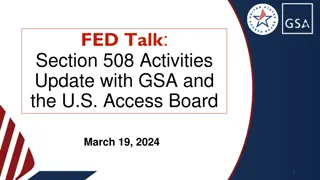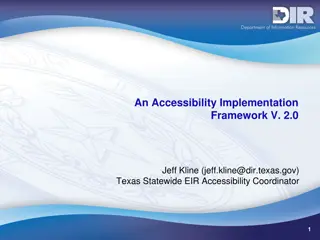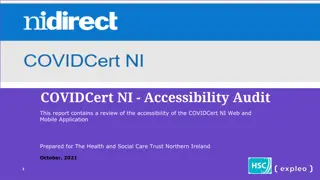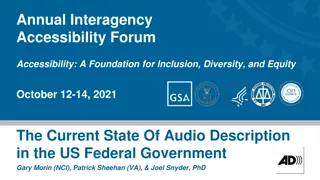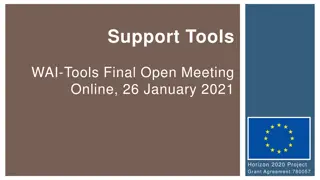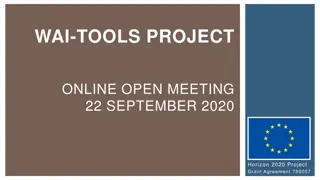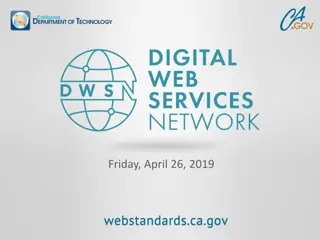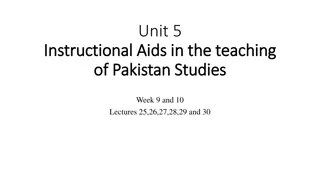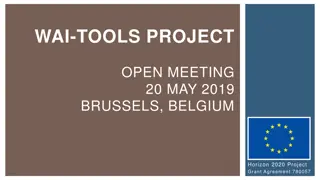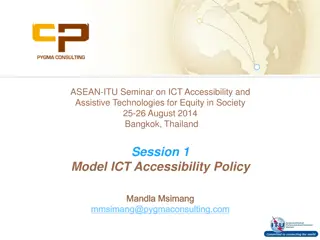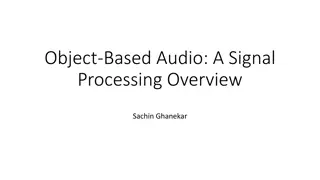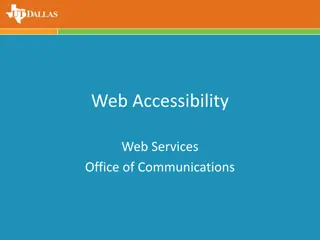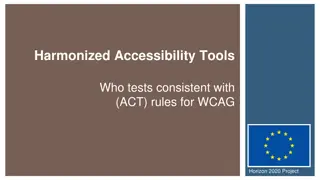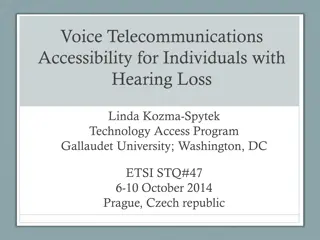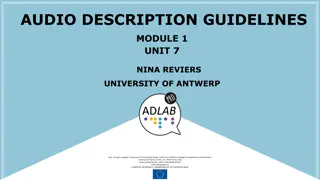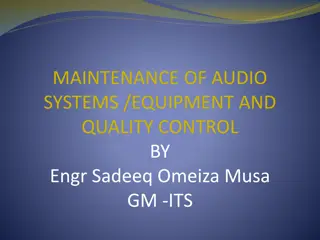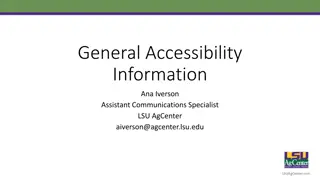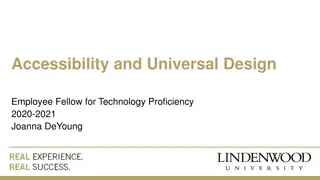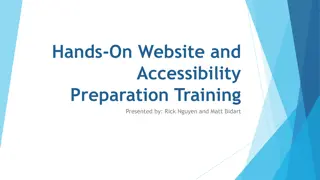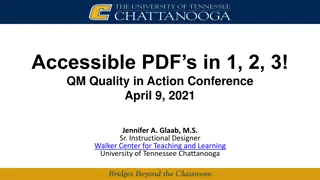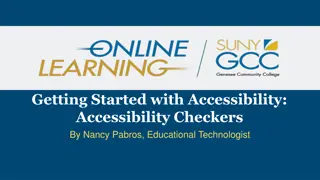Enhancing Audio Description for Accessibility in Europe
Addressing the accessibility of audiovisual products for the blind and visually impaired population in Europe, the ADLAB project aims to create guidelines, develop curricula, train professionals, influence decision-makers, and foster social inclusion. Through various work packages, the project assesses user needs, analyzes text, conducts testing, and formulates guidelines, with a focus on bettering the lives of marginalized communities. Legal situations and available resources are explored, emphasizing the importance of collaboration and understanding. Explore more at www.adlabproject.eu.
Download Presentation

Please find below an Image/Link to download the presentation.
The content on the website is provided AS IS for your information and personal use only. It may not be sold, licensed, or shared on other websites without obtaining consent from the author. Download presentation by click this link. If you encounter any issues during the download, it is possible that the publisher has removed the file from their server.
E N D
Presentation Transcript
ADLAB. Audio Description lifelong access for the blind European Erasmus Multilateral Lifelong Learning project 2011-2014
Partners University of Trieste Autonomous University of Barcelona Polytechnic University of Leiria Artesis, Antwerp University University of Poznan (UAM) BayerischeRundfunk Vlaamse Radio en Televisie (VRT) Senza Barriere
PROJECT OBJECTIVES AND VISION Create authoritative guidelines for the AD profession/industry in all Europe; Develop curricula for universities in EuropeTraining of audio describers and audio describer trainers; Sensitise and influence decision-makers at a local, national and European level; Create useful connections with the industry and with the service providers; Social Inclusion; Improve the lives of the blind and visually impaired population; (but also that of immigrants, those with learning difficulties, language learners, etc.)
WORK PACKAGES WP 1 User Needs Analysis WP 2 Text Analysis and Development WP 3 Testing WP 4 Guidelines
Work Package 1 USER NEEDS Executive Summary The issue addressed in the ADLAB WP1 report on user needs is the current situation in Europe regarding the accessibility to audiovisual products on the part of the blind and visually impaired population. The aim was to achieve a photograph of the situation in Europe particularly regarding the project member states in order to better focus efforts in the succeeding stages of the project.
Questions How many blind and visually impaired people? What is the legal situation? How much audio description is already available? On television, at the theatre, etc. How much research, teaching and training ? What is the role of the national blind associations ANSWERS IN THE REPORT Website <www.adlabproject.eu>
Legal situation The survey demonstrates that various government jurisdictions have formulated different and complex definitions of legal blindness and other forms of visual impairment. As for the specific laws and regulations pertaining to AD, here too there is much variation: countries that have no regulations; countries where very precise guidelines exist for some sectors (e.g. public television in Flanders); countries that are known to have much fuller legislation (e.g. the UK).
Availability of AD Results show a somewhat comparable situation in all the countries involved in the research in that public television typically offers AD services to some extent while the private market is less interested in making its audio-visual productions accessible. Television is the key market!
Updating some DVDs including AD tracks exist in all countries under consideration but often very limited cf. 4 or 5 in Italy; Germany has gone from 130 to 183, Italy from 4/5 to 20; some organisations cater for the needs of the target group, e.g. Italy (Senza Barriere Onlus) and Spain (cf. O.N.C.E.); Senza Barriere s output has risen to 600 Ads, and they have produced a new trainer dvd, the situation in museums seems reasonably positive, and in expansion; This continues but irregularly theatre, opera and ballet - mostly occasional one-off Ads Regular AD provision in theatres is increasing in Spain, Germany, Italy and Flanders almost no cinemas offer AD on a regular basis. Special screenings with AD, are all linked to single initiatives. But watch for latest developments!
AD research and training Our surveys show that in most countries research and educational training are closely linked, as both are typically carried out in universities even if there are no specific professorships or chairs for AD experts. Generally speaking, it is safe to say that AD is only very rarely part of the curriculum at higher education level. New courses and modules based on ADLAB findings are being introduced in Italy, Poland, Flanders and Spain Sometimes training is offered in seminars taught by professionals, or available in-house within companies or on-line (Senza Barriere).
User reception studies investigating the position of national and local blind associations regarding audio description, especially in terms of their lobbying power in promoting the practice. the report includes a list of organizations for each charted country with very varied and detailed answers provided by each. the trend seems to confirm the great importance ascribed to AD by each and every organization, even though their involvement and lobbying power varies and more cooperation is called for.
REPORT Conclusions The general conclusion is that AD is still a media access practice lacking critical mass in terminology, practice, and training Raising awareness at all levels is the first recommendation made by the ITU Audiovisual Media Focus Group, and ADLAB attempted to take forward this recommendation leading to its work on creating guidelines and curricula, and on promoting the practice of audio description whenever and wherever possible.
Work package 2 An extensive text analysis was carried out on the film Inglourious Basterds by all partners, and coordinated by UAB. The film was chosen because ot its myriad varied features, its connections to other films and genres, its use of several languages and basically because of its extreme difficulty for the audiodescriber.
Going beyond This WP was to go beyond what had already been investigated, but only partially answered, with regard to What should be described? What should not be described? How objective should the description be?
How? Eye-tracking technology Psychological studies Systemic-functional linguistics Bottom-up processing
Rationale (Orero) Most studies on audiovisual translation in general (Perego 2005, D az-Cintas & Remael 2007, Franco, Matamala & Orero 2010, Romero-Fresco 2011) were drafted from a top-down approach. While this is the most common and time effective procedure, it tends to yield the information expected from the onset of the experiment and hypothesis drafted. We have with the EU project a unique and too interesting opportunity to have several countries and experts in the field. We decided to embark on a new and challenging research approach: bottom-up, that is following a user-centric approach, and avoiding a pre-determined outcome. We departed for our research and analysis from one common input: Tarantino s Inglorious Basterds (2009).
THE MATRIX Text on screen Music and sounds Intertextual relations Cultural references Secondary elements (content prioritisation) Gestures and facial expressions Cinema tools/camera techniques Spatio-temporal characteristics Characters (describing, naming, placing, ) Audio description wording, language, style
Text-on-screen Logos: Universal Pictures The Weinstein company Opening credits/closing credits/TITLE Inserts/Intertitles (e.g. Kapitel Eins) Inglourious Basterds inscription on the rifle Names captioned and arrowed Maps Newspaper clippings Cinema lettering Shoshana s passport Cards used in game The napkin signed by Bridget Subtitles
Work package 2 the book Work package 2 also spawned a volume published by Benjamins written by ADLAB members and covering all the aspects alluded to above concerning the difficulties encountered in audio describing Inglourious Basterds and their relevance to the audio description world in general.
Book chapters Text on screen Music and sounds Textual Cohesion Intertextual relations Cultural references Secondary elements Gestures and facial expressions Cinema techniques Spatial temporal features Characters Language
Textual Cohesion Cohesion is created in a number of ways within a text and indeed refers only to the links within the discourse, within the co-text, that is created by the words themselves. Eg. by repetition, anaphoric reference, peratining to same semantic field, etc.
But in the case of audio descriptions (ADs) the text is written to be read and needs to be both linguistically cohesive within itself and cohesive with the visual content it describes, both in its original form and in its possible translated form.
And constant cross reference to characters, objects and scenes, which give texture to a film, must be reflected in the AD where a parallel linguistic cross reference gives texture to the description.
And what is more what distinguishes the audio description of film from other forms of text is the fact that its written form is discontinuous, in that it is created around the dialogue of the film. The blind audience receive and interpret both texts and thus the AD has to be cohesive also with the spoken component.
First scene Inglourious Basterds It is summer 1941. A small farmhouse stands in the Nazi-occupied French countryside. A man is chopping wood on a block. He is tall and bearded. A girl is hanging washing on a line. The girl hears something. She moves a sheet she is hanging to see a car approaching along the untarred road leading to the house. The man turns to look, apprehensively, as the vehicle approaches. It is military with motor- cycle outriders.
The AD of this scene There is concision, simple syntax, use of the present tense, third person perspective, objectivity, etc.: AND cohesion
Phasal analysis Very simply a film, like a book, is seen as consisting of a number of major phases (macro-phases) which can in turn be divided into minor phases or subphases. But what defines a phase? As Thibault (2000: 320) puts it, phases are continuous and discontinuous stretches of discourse which share ideational, interpersonal and textual consistency and congruity, i.e. consistent selection from the various semiotic systems .
How does this work? For example, a scene featuring a particular set of characters, in the same setting, with the same register of dialogue, accompanied by a particular piece of music can be recognised as a phase. When the scene or sequence changes and different characters in a different setting with a different musical background takes over, another phase can be identified.
Phases Slight changes in the composition of characters or setting may simply represent a subphase of a macrophase, but are in any case perceivable. A particular phase may appear only once during a film, but usually phases re-emerge at intervals during the length of the feature. They can thus be described as continuous or discontinuous, as mentioned above. This may take place over 50 years cf. Coronation Street
Changes The changes between phases are signalled by transitions, which may consist of immediate scene changes, fade-outs or obviously repeated actions.
ELEME NT Title Chapter s Story theme SCENE VISUAL IMAGES VERBAL COMPONENT Inglourious Basterds Chapter One TRANSITION Logo and lettering Caption: Chapter One, etc. cut cut Caption: Once upon a time Once upon a time 1941 RECCURENT COMPONENT Names: Padite. Col. Hans Landa Family(ies), dairy farm, Jews, The Jew Hunter, milk, enemies state, Shosanna, Goebbels, F hrer Au revoir Shosanna cut VISUAL IMAGES VERBAL TRANSITION 1a French farm/arrival of Nazis Perrier La Entering house 2 Dapite s living room, glass of milk, living room, pipe smoking, people under massacre Landa s hand gesture to be silent. floorboards, of the pipe, 1b Farm, Shosanna s escape Runs into woods. Cut to Chapter Two Inglourious Basterds
Conclusion Following the sequences e.g., 15 a,b,c,d; 22 a,b,c,d,e,f, it can be seen how the film is structured and how the director wants the audience to trace its development. The audio describer should pay attention, consciously or unconsciously, to these cohesive elements in order to provide continuity and cohesion, in both verbal and visual terms, to his or her description.
Intertextuality The Alamo Inglourious Basterds
The testing Impact on the end-users, i.e the blind and sight- impaired community. Comparison of descriptive and narrative approaches measuring levels of comprehension and enjoyment.
The testing study In the study the opening scene from Inglourious Basterds (with two alternative ADs) was shown to a group of VIPs (divided into groups A and B), which was followed by a questionnaire-based interview. For the purposes of comparison, the same clip (without AD) was shown to a control group of sighted respondents, also followed by a questionnaire.
What was tested The tested issues included the opening credits (naming actors with protagonists, AD authors), text- on-screen, naming characters, film terminology and film technique (lighting, camera movement, shots), information sequencing and fragmentation, gestures, describing sounds, intertextual references, explicitation, narration vs. description.
Example The experimental video includes one very interesting intertextual reference. Colonel Landa s pipe resembles that of Sherlock Holmes. The descriptions of the pipe in the two ADs were manipulated so that AD-A included a conventional description without the intertextual reference ( an enormous, saxophone shaped pipe ) while AD-B included the reference ( Sherlock-Holmes-Style Calabash). The respondents were to judge on a 5-point scale (1 definitely not, 5 definitely yes) to what extent the description helped them imagine the actual pipe. Results in the report www.adlabproject.eu
Conclusion In conclusion, WP3 identified troublesome aspects of AD and highlighted the need to adopt individual strategies instead of general across-the-board guidelines. As in any other type of translation, individual solutions are decided upon in a given context that should be carefully considered by the decision-maker, i.e. the audio describer.
Which brings us the the manual The guidelines that have been adopted thus far, however valid locally, are rarely based on empirical research, in most cases being the result of experience, common sense and personal preferences For ADLAB the decision was made, taking into consideration all that had been learnt en route, to formulate strategic guidelines for the manual.
The Innovators from Antwerp Taking into account the results obtained from both the text analysis and testing phases of the project, all members were provided with tasks coordinated by the University of Antwerp team. After considerable thought and discussion, it was decided to create strategic guidelines rather than produce prescriptive rules and these would be presented in the form of a manual and published as an e-book.
no set solutions These innovative guidelines suggest strategies for dealing with particular, commonly met situations. In other words, there are no set solutions to AD problems but there are ways of dealing with them in particular circumstances. The guidelines thus take the form of advice, but based on meticulous analysis and testing, and organized under the headings that appear in the report on text analysis and associated book (spatio-temporal issues, film language, textual cohesion, etc.) .
INTERESTED PARTIES Universities (training/research) Blind Associations Media producers Film distributors AD service providers Politicians,undersecretaries, administrators, International organisations e.g.. ONU, UNESCO Disseminate the manual e.g., to the more than 70 universities in Italy. Prize given in Calabria. Dissemination conference
DYNAMIC WEB SITE Open to all and adapted for all users; Constantly updated; www.adlabproject.eu
EXPLOITATION and SUSTAINABILITY Final conference Brussels 19th September HBB4ALL MOOC Knowledge Alliance, etc. Languages and the media!
MAIN PRODUCTS (deliverables) Reports on work packages. Book on AD - Audio Description: new perspectives illustrated Manual (e-book + hard copies in English and German). Course curricula.


